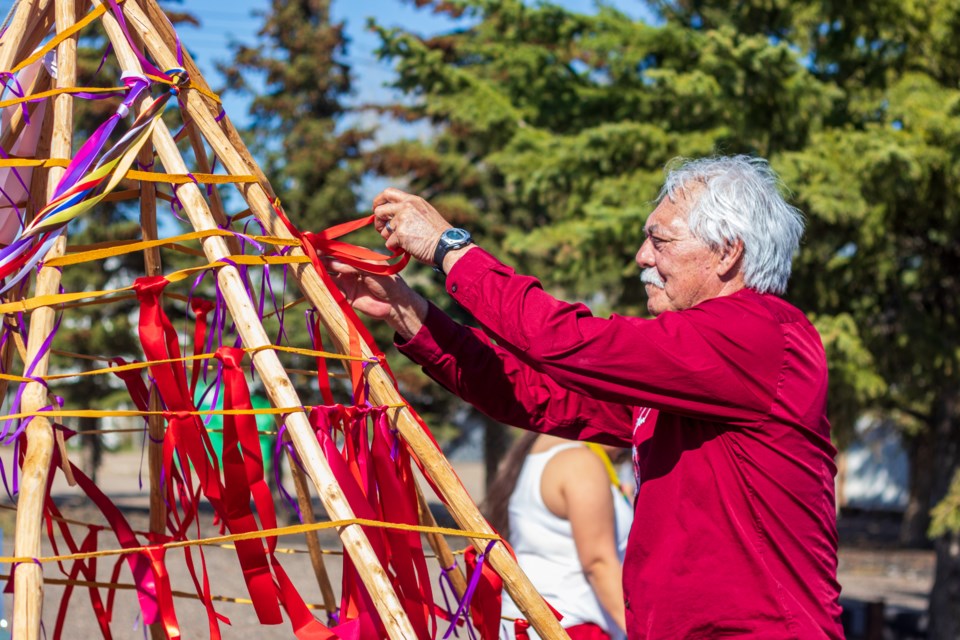ST. PAUL – The only escape from the blazing sun at the St. Paul Lion’s Park was the shade of trees, where a man handed out strips of red ribbon to a long line of people. One by one, each found a spot to sit down.
With a marker, they wrote the names of lost, loved ones on the red ribbons. Then, at the centre of the park was a small teepee, where people proceeded to tie the ribbons. Not too long after, the teepee had vibrant red ribbons swaying gently in the breeze.
On May 5, the Mannawanis Native Friendship Centre (MNFC) held a red ribbon ceremony in honour of the MMIWG2S (Murdered Missing Indigenous Women Girls 2 Spirit) at the St. Paul Lions Park.
Prior to the ceremony, Gail Collins, outreach worker at MNFC and coordinator of the red ribbon ceremony, spoke to Lakeland This Week.
“It's a day in which we honour the murdered and missing Indigenous women, and we are not forgetting the men and the boys that have also been murdered or missing,” said Collins, with a soft voice.
She explained the teepee is a significant symbol to the Indigenous peoples, representing “the circle of life.” The ceremony also included songs and prayers, where the “spirits of the ones that have passed on” were invited.
At the end, there was a song “in which we send the spirits home.” The ceremony is important, not only as part of Indigenous culture, but also a way knowing “we don’t forget them,” she said.
Collins believes the Indigenous community has a responsibility to be responsive to MMIWG2S, adding that there is still a lot of work that needs to be done. This includes work at various levels of government.
National Crisis
On May 2, NDP MP Leah Gazan presented a motion to declare the MMIWG2S crisis a Canada-wide emergency, just days before the May 5 National Day of Awareness for Missing and Murdered Indigenous Women and Girls and two-spirit People.
“We are witnessing a crisis of unrelenting violence against our women, girls and two-spirit people,” said Gazan. “Just three days ago, the remains of an eight-year-old girl were found in Samson Cree Nation in Maskwacis and my heart goes out to her family. We are not disposable — our lives are precious, and we deserve justice.”
Gazan added, “It’s time for immediate action from this government, including declaring a Canada-wide emergency and putting in place a Red Dress Alert, to save lives.”
Collins said she was glad to hear the news, adding that efforts must also be made at the local level also.
“There’s a need, it touches a lot of people, and it’s not going to go away if we don’t do things right,” she said. She also spoke about systemic issues that contribute to the vulnerability of Indigenous women, such as domestic violence.
Many core issues like poverty and a lack of housing also need to be discussed and addressed. These are factors that lead to Indigenous women becoming “a target,” said Collins.
In addition, “we need to have some sort of a central place where people can go,” she said, such as a MMIWG2S-dedicated task force or an office, which would include a place people can call. She believes dedicated support and services to investigate specific MMIWG2S cases would also help.
“It's not an isolated incident. And I'd like to see the community, St. Paul, and the Indigenous community... start that dialogue and work together,” said Collins.
Not just one day
Hinano Rosa, executive director at the Mannawanis Native Friendship Centre, emphasized the importance of continuing to raise awareness about MMIWG2S beyond the national day of awareness.
To achieve this, the MNFC is planning a conference on MMIWG2S to engage the community about the issue. “When you look at the stats, right now, the percentages are so high, compared to other ethnic groups in Canada,” Rosa explained.
A May 2019 report by the Department of Justice stated that in 2014, the rate of violent victimization of Indigenous women is double that of Indigenous men, and triple that of non-Indigenous women.
Also, according to a Statistics Canada report released in 2021, the 2020 rate of homicide for Indigenous peoples was close to seven times higher compared to non-Indigenous peoples. Indigenous men have the highest rate, followed by Indigenous women.
“We need this community to know, that the more allies we get in our efforts to address it and making that a frontline issue,” the better it is not only for the Indigenous people but all Canadians, said Rosa.
He plans the conference to also provide support for survivors and families.
“Some of our planning around the funding is to help survivors and families that have experienced this firsthand - to work through their grief and trauma, to work through the loss of not knowing where your loved one is, because they haven't shown up,” Rosa said.
MNFC also aims to reach out to different “ethnic groups” in St. Paul. “This is not a battle that the Indigenous people can fight alone... it has to be all of us in Canada – as Canadians.”
“St. Paul could be the model of what reconciliation could look like. What supporting one another could look like,” Rosa said. “We need to make this happen every day.”



